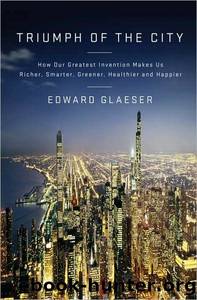Triumph of the City: How Our Greatest Invention Makes Us Richer, Smarter, Greener, Healthier, and Happier by Edward Glaeser

Author:Edward Glaeser [Glaeser, Edward]
Language: eng
Format: epub
Tags: Business & Economics, Urban & Regional, History, World, Social Science, Sociology, Urban
ISBN: 9780143120544
Google: GeRBkgEACAAJ
Amazon: 0143120549
Barnesnoble: 0143120549
Publisher: Penguin Books
Published: 2011-02-10T00:00:00+00:00
What’s Wrong with Sprawl?
In the nineteenth century, economics drove the growth of America’s cities. People moved to places, like Chicago, that were economic engines. In the twentieth century, an increasingly affluent population started making choices based on quality of life as well as wages. Los Angeles’ early growth came from its oil wells and its port, but also from the allure that its climate had for retiring Midwestern farmers or footloose authors, like L. Frank Baum and Edgar Rice Burroughs. When people move to places that are more productive, the country as a whole becomes more economically vibrant. When people move to pleasant places, they enjoy life more, and when they move to more temperate climates, they use less energy.
But in the late twentieth century, public policies, both national and local, started playing an outsize role in urban change. As we’ve seen, the fastest growing places in the United States—Atlanta, Dallas, Houston, and Phoenix—are growing not because of high wages and temperate climates but because their governments are friendlier to new development than older communities in California and the Northeast. The path of America’s future is being determined by the whims of local zoning boards that don’t want more people living in their highly productive, pleasant communities.
A different set of policies has played an equally important but largely hidden role, pushing people to suburbanize. I am sufficiently unusual that I’m always cautious about using my own life to infer anything about anyone else’s, but my decision to suburbanize was a conventional one, driven for the most part by common factors. At the start of this chapter, I listed the forces that brought me to a suburb: living space, soft grass for spill-prone toddlers, a desire to diversify my life with greater distance from my employer, a fast commute, and good schools. Of these five factors, only two—the grass and distance from Harvard—are independent of public policies.
My wife and I were pretty sure that we wanted to live someplace where we could eat out anonymously, but that didn’t necessarily imply living in a suburb. We could have moved to Boston, which is a charming and pleasant city. One of the factors that pushed against Boston is that a five-mile commute from an urban apartment across the Charles River would have been no quicker than a fifteen-mile drive in from the suburbs. If I leave early enough, that drive takes me less than twenty-five minutes, thanks to the interstate highway system, which was generously subsidized by the federal government. My commute itself is on a highway that was funded by tolls, but when I drive to the airport, I rely on a recent expensive extension largely funded by state and federal largesse. As a matter of public policy, I remain skeptical of the $15 billion Big Dig, but I’d be foolish not to use it when I drive to Logan. My commute is also cheap because American governments have, unlike their European counterparts, decided not to heavily tax gasoline.
Another factor that pushed us to the suburbs was the cost of living space.
Download
This site does not store any files on its server. We only index and link to content provided by other sites. Please contact the content providers to delete copyright contents if any and email us, we'll remove relevant links or contents immediately.
International Integration of the Brazilian Economy by Elias C. Grivoyannis(91447)
The Radium Girls by Kate Moore(11926)
Turbulence by E. J. Noyes(7940)
Nudge - Improving Decisions about Health, Wealth, and Happiness by Thaler Sunstein(7622)
The Black Swan by Nassim Nicholas Taleb(7016)
Rich Dad Poor Dad by Robert T. Kiyosaki(6413)
Pioneering Portfolio Management by David F. Swensen(6229)
Man-made Catastrophes and Risk Information Concealment by Dmitry Chernov & Didier Sornette(5924)
Zero to One by Peter Thiel(5690)
Secrecy World by Jake Bernstein(4651)
Millionaire: The Philanderer, Gambler, and Duelist Who Invented Modern Finance by Janet Gleeson(4382)
The Age of Surveillance Capitalism by Shoshana Zuboff(4214)
Skin in the Game by Nassim Nicholas Taleb(4165)
Bullshit Jobs by David Graeber(4100)
The Money Culture by Michael Lewis(4082)
Skin in the Game: Hidden Asymmetries in Daily Life by Nassim Nicholas Taleb(3935)
The Dhandho Investor by Mohnish Pabrai(3704)
The Wisdom of Finance by Mihir Desai(3658)
Blockchain Basics by Daniel Drescher(3511)
